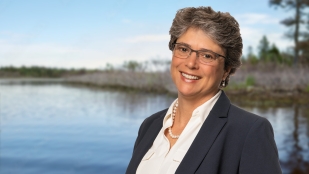Understanding the Importance of Characterizing Large Storms for Stormwater Management

Stormwater management, a key component of municipal planning, is designed to reduce flood risks and help ensure the sustainability of urban infrastructure. In his June 2024 Stormwater Solutions article, Robert Czachorski, Principal and Collection Systems Practice Leader at OHM Advisors, emphasizes the criticality of properly characterizing large storms, reinforcing the importance of his insights for our professional community.
Czachorski explores the implications for stormwater professionals and the broader civil engineering community.
The 1,000-Year Storm Misunderstanding
One of the fundamental misconceptions in stormwater management is the interpretation of storm frequencies, particularly the so-called 1,000-year storm. This term often leads the public to believe that such storms should only occur once every millennium. However, Czachorski clarifies that these statistics are calculated for specific points, not regions or nations.
Consequently, while a 1,000-year storm at a single location is rare, multiple such events can occur more frequently across large areas like metropolitan regions. This misinterpretation can have significant, even life-threatening, consequences for planning and public safety, underscoring the urgency of addressing this issue.
Practical Application of Point vs. Regional Data
Czachorski illustrates the importance of accurate storm characterization through a case study of Detroit. Using 11 years of data from 33 rain gauges, he conducted a regional rainfall analysis, revealing that while a 1,000-year storm might seem extraordinarily rare at a single point, such storms could occur approximately every 13.7 years in Detroit.
This finding underscores the necessity for regional rainfall analyses in urban planning to avoid underestimating the frequency and impact of large storms.
Enhancing Infrastructure Resilience
The implications of these findings for civil engineering and public policy are profound. Misinterpreting storm frequency data can lead to under-designed infrastructure that cannot cope with the actual frequency of extreme weather events.
This not only endangers public safety but also increases maintenance and repair costs. Therefore, stormwater professionals must clearly communicate the nuances of rainfall statistics to policymakers and the public, to develop infrastructure designs that are robust and resilient.
Educating Stakeholders
Effective communication of rainfall data and storm frequencies is crucial. Stormwater professionals must strive to educate stakeholders, including the public and elected officials, about the realities of storm statistics.
Using precise language and providing context can help demystify terms like the 1,000-year storm, ensuring that all parties understand what these terms mean for municipal planning and design.
Best Practices for Storm Characterization
To improve stormwater management practices, stormwater professionals can adopt several best practices:
- Be Aware of Regional Rainfall Data: Whenever possible, communicate both regional rainfall data and point-specific data to better understand the true frequency of large storms within your system.
- Educate Stakeholders: Provide clear and precise explanations of storm frequency data to stakeholders, ensuring they understand the implications for urban planning and infrastructure design.
- Regularly Update Data: Keep rainfall frequency data current, reflecting the latest research and climate models.
Conclusion
Properly characterizing large storms is critical for effective stormwater management and urban planning. Misinterpretations of storm frequency data can lead to under-designed infrastructure and more risks for system owners than they may have expected.
By understanding regional rainfall data, educating stakeholders, integrating climate change considerations, and regularly updating data, stormwater professionals can enhance the resilience and safety of urban infrastructure. Czachorski's insights provide a valuable framework for understanding and addressing these challenges, ensuring that stormwater management practices are robust and forward-looking.
How can I learn more?
By staying informed and adopting best practices, stormwater professionals can help our cities be well-prepared to face the challenges posed by large storms and changing climate conditions.
For more detailed insights and practical guidance on stormwater management:
- OHM Advisors Expert Explains Antecedent Moisture Modeling for Optimized Sewer Collection Systems (VIDEO)
- Czachorski Authors Best Practices Article in Water Environment Foundation’s WE&T Magazine
- Flow Metering 101: A Guide to Measuring Flow
Contact Robert Czachorski directly at Robert.czachorski@ohm-advisors.com or visit our Water expertise content for more on how we build healthier communities.



